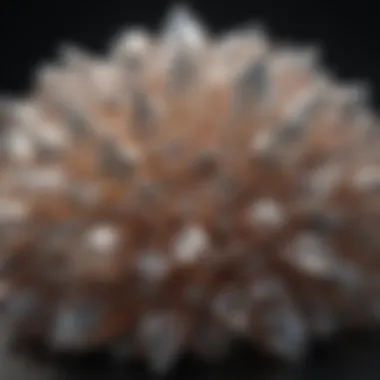Unlock the Secrets: How to Identify the Crystal You Possess with Precision


Rock and Fossil Identification
As a dedicated crystal enthusiast, it's crucial to understand the types of rocks and fossils that may resemble or be related to crystals. Rocks like quartz, amethyst, and agate share similarities with certain crystals, making it essential to distinguish between the two. Fossils, on the other hand, offer glimpses into Earth's history through preserved remains or traces of ancient life. By familiarizing yourself with these distinctions, you can avoid misconceptions and accurately identify the crystals in your possession.
- Types of rocks and fossils: When examining rocks, consider common crystal-like structures such as geodes or sheer formations that may mimic crystals. Fossils can vary from imprints of plants and animals to actual skeletal remains, showcasing a different aspect of Earth's past.
- Characteristics to look for: Key characteristics like color, translucency, hardness, and crystal habit can aid in identifying crystals. Rocks may exhibit smooth textures or distinct layers, while fossils often showcase intricate details of organisms long extinct.
- Tools for identification: Utilize tools like hand lenses, UV lights, and scratch tests to differentiate between rocks, fossils, and crystals effectively. These tools can reveal hidden details and provide valuable insights into the composition of your specimen.
Introduction
In the realm of crystals and gemstones, the ability to accurately identify the specimens in one's possession is a fundamental skill that transcends mere curiosity. This introductory segment serves as the gateway to unlocking the enigmatic world of crystals, offering insights to both seasoned collectors and novice enthusiasts. Understanding how to identify crystals not only enhances one's appreciation for these natural treasures but is also crucial for determining their properties and potential significances.
As we embark on this exploration, it becomes evident that the importance of crystal identification extends far beyond a mere labeling exercise. From unraveling the unique metaphysical properties of crystals to discerning their geological origins, the process of identification unveils a tapestry of knowledge waiting to be discovered. By delving into the intricacies of crystal characteristics and formations, individuals can forge a deeper connection with the mysterious allure of these geological wonders.
Furthermore, the significance of crystal identification extends to practical applications such as assessing the value of specimens, distinguishing between similar-looking crystals, and even potentially uncovering rare or unique varieties. Whether one's interest lies in holistic healing, jewelry making, or scientific study, grasping the nuances of crystal identification acts as a foundational pillar in navigating the diverse and captivating world of crystals.
In this article, we set out to demystify the process of identifying crystals, offering readers a comprehensive roadmap teeming with expert advice and practical tips. By elucidating the essential aspects of crystal identification and equipping our audience with the requisite knowledge, we aim to empower individuals to embark on their own crystal identification journeys with confidence and precision.
Understanding Crystals
Understanding crystals is a fundamental aspect of delving into the world of crystal identification. Whether you are an experienced collector or a curious beginner, grasping the essence of crystals is paramount in distinguishing one crystal from another. By comprehending the unique characteristics and properties of crystals, individuals can accurately identify the crystals in their possession. This section will delve deep into the significance of understanding crystals within the context of crystal identification.
What are Crystals?


Crystals are solid substances with a regular atomic structure comprised of a myriad of atoms, ions, or molecules. They form through a process known as crystallization, where particles align in a repeating pattern, giving rise to distinct geometric shapes. The atomic arrangement within crystals leads to their unique optical, electrical, and physical properties. Understanding the fundamental definition of crystals is pivotal in discerning their diverse nature and allows individuals to appreciate the beauty and intricacy of these geological marvels.
Types of Crystals
Crystals come in a vast array of types, each characterized by specific chemical compositions, structures, and colors. From common quartz and amethyst to rare diamonds and emeralds, the world of crystals is a treasure trove of diversity. Different types of crystals exhibit varying properties such as hardness, cleavage, and color, making them identifiable through careful observation and analysis. This section will explore the various categories of crystals, shedding light on the distinguishing features that set each type apart. By understanding the different types of crystals, enthusiasts can broaden their knowledge base and enhance their ability to recognize and classify crystals effectively.
Physical Characteristics
In the realm of crystal identification, understanding the physical characteristics plays a pivotal role. The physical attributes of a crystal can offer valuable insights into its composition, origin, and even potential uses. One of the key aspects to consider is color, which can vary vastly across different types of crystals. The color of a crystal is determined by the presence of certain minerals or elements, giving each crystal its unique hue. Transparency is another critical factor to assess, indicating how much light can pass through the crystal. This characteristic can range from transparent to opaque, showcasing the crystal's internal structure. Furthermore, luster serves as a vital indicator of a crystal's quality and surface shine. Crystals can exhibit various types of luster, such as vitreous, metallic, or pearly, based on their molecular structure and light reflection properties.
Color
Color is a fundamental aspect of crystal identification, offering valuable clues about the crystal's composition and properties. Different crystals boast a wide spectrum of colors, ranging from vibrant hues to subtle tones. The color of a crystal is influenced by the presence of specific mineral impurities or defects within its structure. For instance, amethyst crystals derive their distinctive violet color from traces of iron or manganese. Observing the color intensity, saturation, and any unique patterns or zoning within the crystal can help pinpoint its exact type. Additionally, changes in color under different light sources or angles can provide further insights into the crystal's characteristics.
Transparency
The transparency of a crystal refers to its ability to transmit light, which can range from fully transparent to entirely opaque. Transparent crystals allow light to pass through with minimal interference, showcasing their internal clarity and purity. On the other hand, opaque crystals block light entirely, concealing their interior structure. Some crystals may exhibit varying degrees of transparency, known as translucent, where light is partially diffused. Evaluating the transparency of a crystal can unveil details about its mineral composition and formation history, aiding in accurate identification.
Luster
Luster pertains to the surface shine or reflectivity of a crystal, reflecting its quality and physical properties. Crystals can display diverse types of luster based on their molecular arrangement and light interaction. The most common luster types include vitreous, which resembles glassy shine, metallic, resembling metal surfaces, and pearly, exhibiting a soft, iridescent sheen. Assessing the luster of a crystal involves observing how light reflects off its surface, which can vary from dull to brilliant. Understanding the luster of a crystal can help differentiate between similar-looking specimens and provide essential clues for identification.
Crystal Formation


Crystal formation plays a crucial role in understanding the composition and properties of crystals. In this article, delving into crystal formation sheds light on how crystals take shape and develop unique characteristics. By exploring the process of crystal formation, readers gain insights into the intricate patterns and structures that define different crystal types. Understanding crystal formation provides a foundation for identifying crystals accurately, as each formation process contributes to distinct physical attributes and properties of crystals. Being aware of crystal formation enhances the ability to differentiate between various crystal specimens, enhancing the overall appreciation and knowledge of crystals.
Geometric Shape
The geometric shape of a crystal is a key indicator of its identity and characteristics. Geometric shapes result from the crystalline structure of minerals, showcasing specific angles, edges, and faces that are unique to each crystal type. By examining the geometric shape of a crystal, collectors and enthusiasts can determine its mineral composition and classification. Different minerals exhibit varying geometric shapes due to their molecular arrangements during crystallization. Understanding the geometric shape of crystals aids in the identification process, allowing individuals to match crystals to specific mineral groups based on their distinctive forms. Analyzing the geometric features of a crystal provides valuable clues about its geological origins and formation history, enriching the experience of exploring crystals.
Internal Structure
The internal structure of a crystal pertains to the arrangement of its atoms and molecules within the crystalline lattice. This structural organization influences the physical and optical properties of crystals, such as transparency, color, and hardness. By examining the internal structure, one can determine the symmetry, cleavage, and other defining characteristics that contribute to the overall appearance of a crystal. Understanding the internal structure of crystals is crucial for identifying their mineral species accurately, as different minerals exhibit specific atomic arrangements. Analyzing the internal structure offers insights into the stability and durability of crystals, aiding in their classification and recognition within the realm of crystal collecting and study.
Testing Methods
Understanding the properties of crystals is essential for any enthusiast or collector. Testing methods play a crucial role in this endeavor. By utilizing various testing methods, individuals can determine key characteristics of their crystal, aiding in its identification process. Among the methods discussed in this article, the Hardness Scale, Streak Test, and Density evaluation offer valuable insights into the composition of a crystal. Employing these techniques can provide clarity on the specific attributes of a crystal, allowing for accurate classification and appreciation of its unique properties.
Hardness Scale
One of the fundamental testing methods in crystal identification is the Hardness Scale. This scale, developed by Friedrich Mohs, ranks minerals and crystals based on their scratch resistance. By assessing the hardness of a crystal using the Mohs scale which ranges from 1 (softest) to 10 (hardest), individuals can narrow down potential options and determine the exact material they are dealing with. The Hardness Scale helps distinguish between similar-looking crystals and provides a quantitative measure that aids in accurate identification.
Streak Test
Another valuable testing method is the Streak Test. This method involves rubbing the crystal against a rough surface to observe the color of the powder left behind. The color of the streak can differ from the external appearance of the crystal, providing vital clues about its internal composition. By conducting a Streak Test, collectors can gain insights into the mineral's true color, helping differentiate between minerals with similar external features. This simple yet effective test contributes significantly to the accurate identification of crystals.


Density
The Density test is instrumental in determining the specific gravity of a crystal. By measuring the mass of a crystal and comparing it to the volume it occupies, individuals can calculate its density. This information is valuable for distinguishing between minerals with similar appearances but different densities. The Density test aids in elucidating the internal structure of a crystal, offering insights that enhance the accuracy of its identification. Understanding the density of a crystal is essential for discerning its composition and properties, contributing to a comprehensive analysis of the specimen.
Identifying Your Crystal
In this comprehensive article on identifying crystals, the section aimed at helping individuals discern the type of crystal they possess plays a crucial role. For both seasoned collectors and novice enthusiasts, pinpointing the exact characteristics and properties of a crystal is paramount. By mastering the methods and techniques outlined in this specific section, readers will gain a profound understanding of their crystal, enabling them to delve deeper into its origins, significance, and potential uses.
Research and Reference
Research and reference are fundamental components when embarking on the journey of crystal identification. By delving into textbooks, academic papers, and reliable online resources, individuals can gather valuable insights into the distinct features of their crystal. Engaging in meticulous research enhances one's knowledge base, allowing for a more accurate assessment of the crystal's composition, history, and metaphysical properties. Referencing established works and expert opinions helps validate findings and ensure the credibility of the identification process.
Consulting Experts
Seeking guidance from experienced crystal experts can provide invaluable assistance in the identification process. Consulting with professionals who possess in-depth knowledge of various crystals can offer unique perspectives and interpretations. Experts can offer insights into rare or unusual crystals that may challenge conventional identification methods. Their expertise can help clarify uncertainties, resolve discrepancies, and uncover hidden characteristics that the untrained eye might overlook. Collaborating with experts fosters a deeper appreciation for crystals and ensures a more thorough and accurate identification.
Online Crystal Databases
Exploring online crystal databases is a convenient and efficient way to access a wealth of information regarding crystal identification. These databases house extensive catalogs of crystal types, accompanied by detailed descriptions, images, and properties. Leveraging these resources allows individuals to compare their crystal's attributes with those listed in databases, aiding in the elimination or confirmation of potential matches. Online crystal databases serve as virtual encyclopedias for crystal enthusiasts, offering a comprehensive platform for research, identification, and knowledge sharing.
Conclusion
In the realm of crystal identification, the conclusion serves as the culmination of a detailed journey unveiling the mysteries and intricacies of crystals. By delving deep into the methods and techniques of crystal analysis, enthusiasts and collectors alike can unlock the secrets held within these mesmerizing gemstones. This final section encapsulates the significance of the entire article, emphasizing the critical nature of accurately identifying the crystals in one's possession.
The importance of the conclusion lies in its ability to provide closure and clarity to individuals seeking to understand the unique properties and characteristics of their crystals. It serves as a compass guiding them through the vast universe of crystals, ensuring that they not only admire their beauty but also appreciate their essence and individuality. By following the steps outlined in this article, readers are empowered to navigate the world of crystals with confidence and precision.
Furthermore, the conclusion offers a comprehensive overview of the key elements discussed throughout the article, bringing together insights on physical characteristics, crystal formation, testing methods, and practical tips for identification. It consolidates all the information presented into a coherent narrative, allowing readers to synthesize their knowledge and apply it effectively in their crystal-related endeavors.
Moreover, the conclusion highlights the benefits of a well-rounded understanding of crystal identification, such as enabling collectors to build a robust collection based on accurate categorization and ensuring that enthusiasts can harness the unique energies and properties of each crystal for spiritual or healing purposes. It underscores the importance of attention to detail and diligence in research, emphasizing that the journey of crystal identification is as enriching as the destination.







